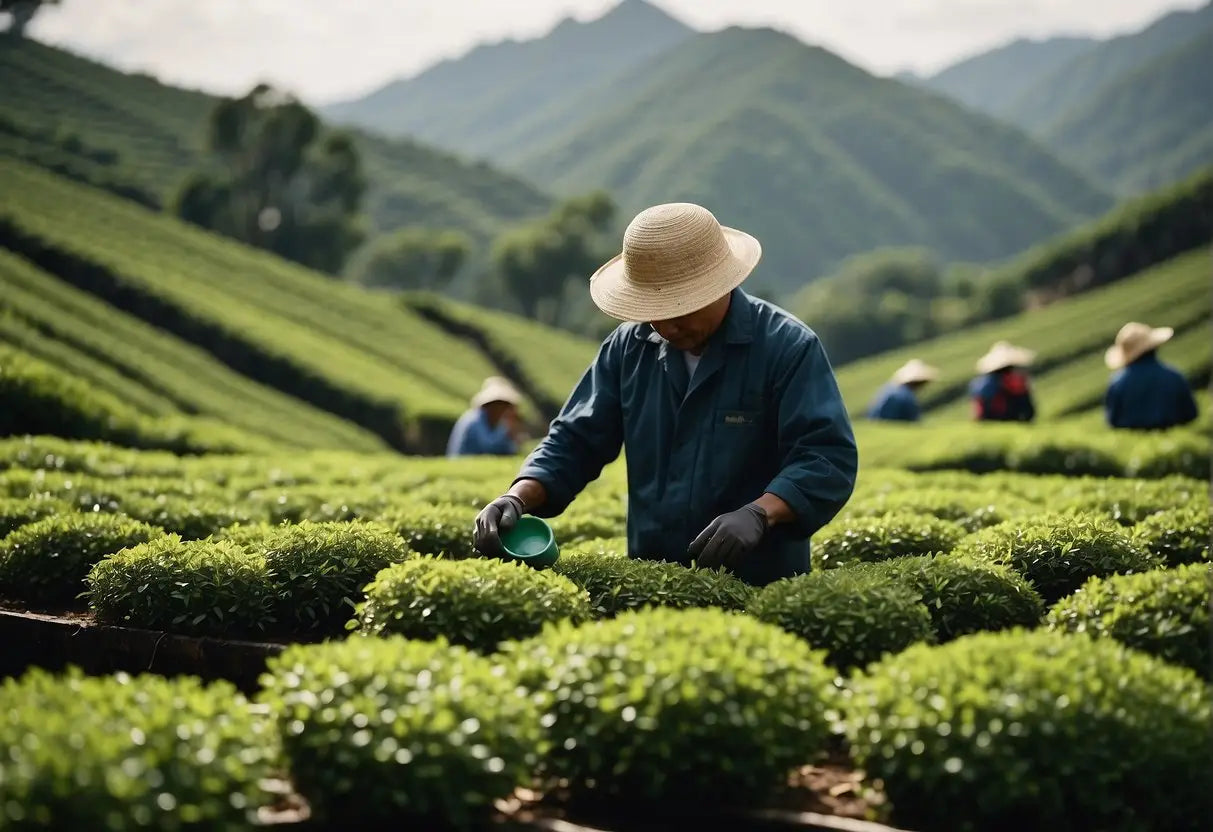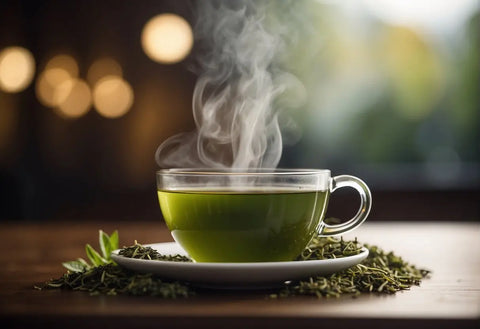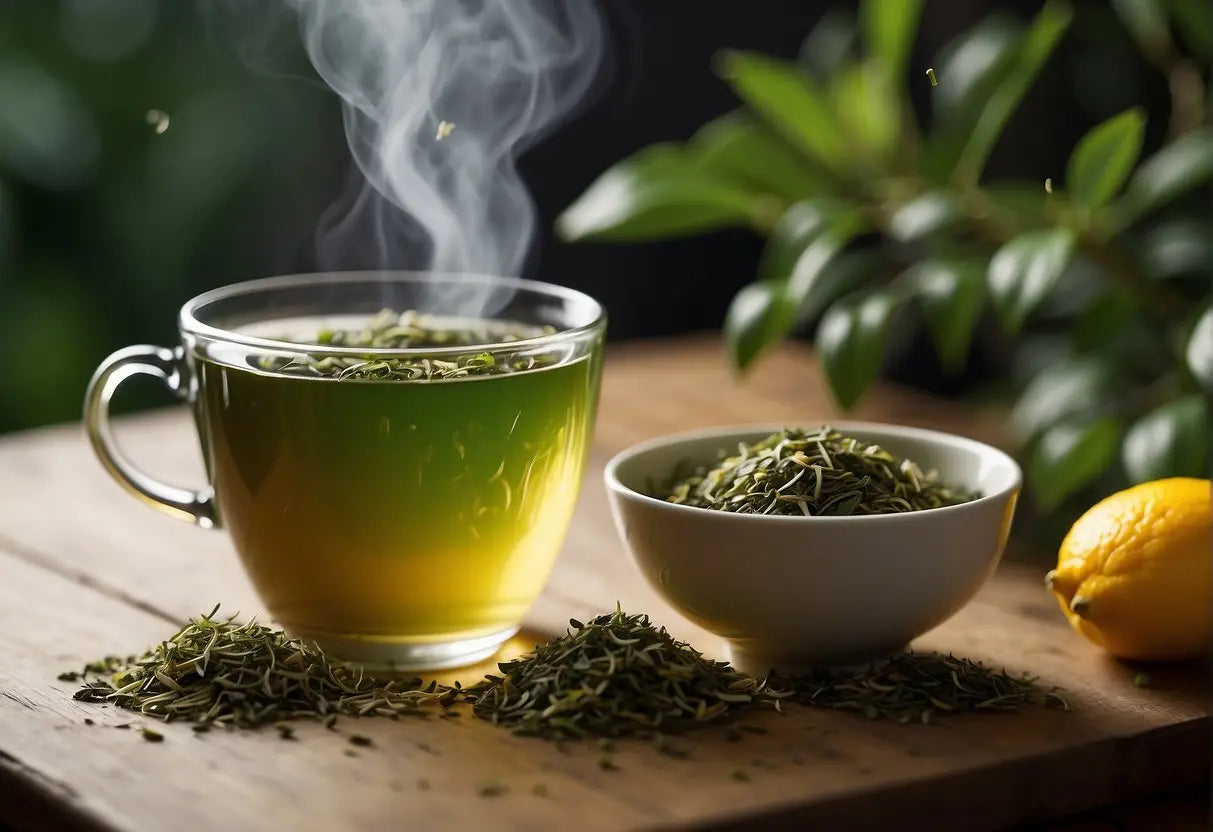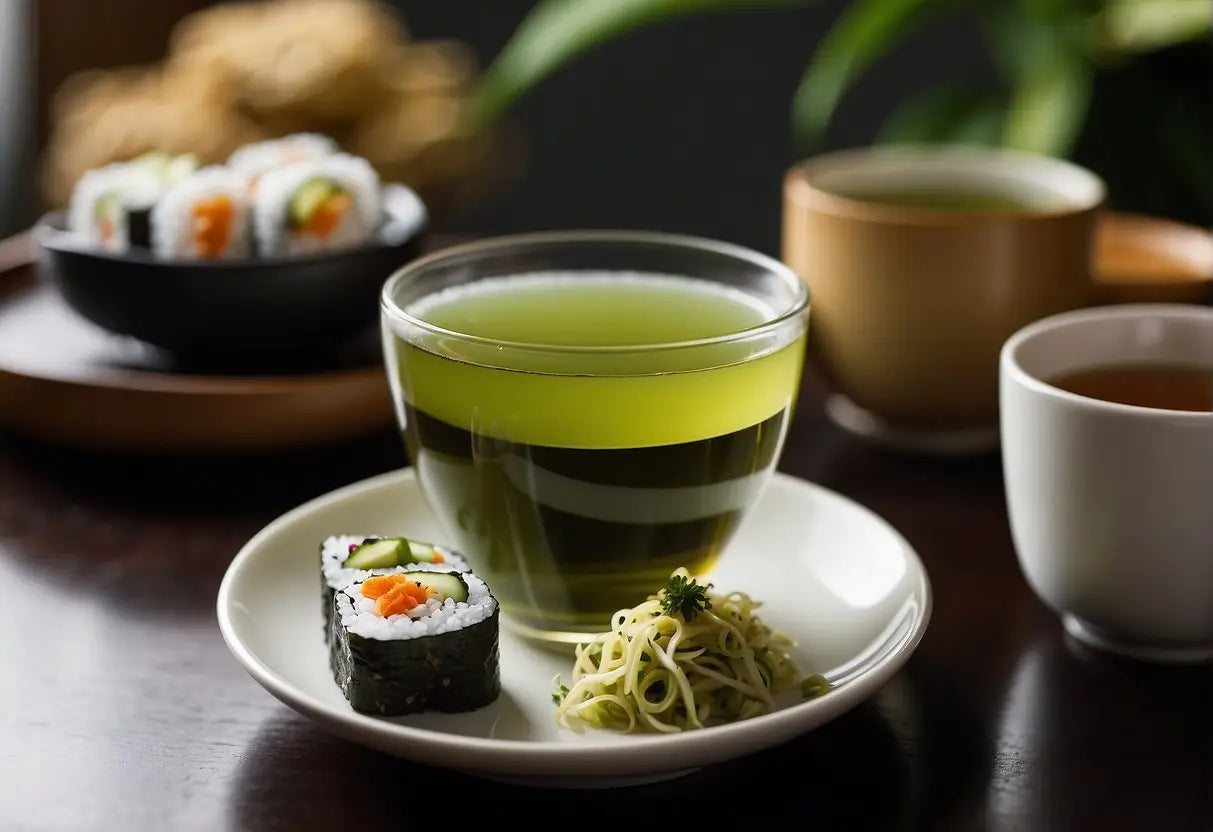Sencha Tea
Sencha tea is a type of Japanese green tea that is widely appreciated for its balance of sweetness and astringency. It is made from the first or second flush of Camellia sinensis leaves, which are the same leaves used to make many other types of teas.
After harvesting, these leaves undergo minimal processing. Unlike other green teas, Sencha leaves are steamed, a method that preserves their green color and fresh flavor. This steaming process typically lasts between 15 to 45 seconds and prevents oxidation, thus maintaining the tea’s vibrant color and delicate, vegetal taste.
The steamed leaves are then rolled, shaped, and dried, which creates the needle-like appearance characteristic of Sencha. The quality of Sencha can vary significantly, often reflected by its color—bright green being a typical indicator of higher quality. Below is a brief outline of Sencha’s key characteristics:
Bestsellers
- Origin: Japan
- Processing: Steamed, Rolled, and Dried
-
Flavor Profile:
- Sweetness
- Astringency
- Vegetal Notes
- Oceanic Undertones
Indulging in a cup of Sencha, you'll taste the nuanced flavor resulting from this meticulous process. You're likely to experience a complex blend of flavors, encapsulating earthy notes with a pleasing, lively finish.
When brewing, water temperature and steeping time are crucial to extract the perfect balance of flavors. Hot, but not boiling, water is recommended, and steeping typically lasts for one to two minutes. This precise preparation yields a refreshing cup of Sencha tea, emblematic of Japan's tea culture and tradition.
History of Sencha Tea
Originating in the 17th century, sencha is a Japanese green tea that you might recognize by its distinctive, needle-shaped leaves. Unlike matcha, which is ground into a powder, sencha leaves are infused to create a clear, green-hued tea.
The method of steaming fresh tea leaves to prevent oxidation was brought to Japan by Sō Shitsu VI, an influential tea master. This introduced you to the unique taste profile of sencha: a balance of sweetness and astringency.
By the 18th century, as cultivation techniques improved, sencha became accessible to the general public. This growth in popularity made it an integral part of your daily life in Japan, enjoyed for its refreshing flavor and health benefits.
Key Milestones:
- 17th Century: Introduction of sencha by tea master Sō Shitsu VI
- 18th Century: Widespread popularity among the masses
- Today: Presence in global markets as a premium healthy beverage
Your understanding of sencha tea would be incomplete without acknowledging Nagatani Soen, often credited with perfecting the sencha processing method in the 1730s, influencing how you enjoy sencha today. His innovation involved steaming, rolling, and drying the leaves in a way that preserves their color and taste.
The tale of sencha is one of evolution and adaptability, grounded in tradition yet embraced in modernity. With each sip, you're part of a historical journey from past to present.
Production Process

The production process of sencha tea involves a series of meticulous steps, each critical for achieving its distinctive taste and quality.
Cultivation
You'll find that sencha tea plants thrive in well-drained, fertile soil. These plants are often grown in full sun but can be shaded for a period before harvesting to alter the flavor profile, resulting in a milder, sweeter tea.
Harvesting
The harvesting of sencha leaves typically occurs in the first or second flush, when the leaves are young and tender. The precise timing of the harvest is crucial, as it influences the final taste and aroma of the tea.
Lao Ban Zhang
- First Flush: usually in late April to early May
- Second Flush: often in June or July
Steaming
Immediately after harvesting, sencha leaves undergo steaming for about 15 to 20 seconds. This quick process halts oxidation, preserving the green color and fresh flavor.
- Purpose: to stop oxidation, maintain color
- Duration: short, precise timing
Rolling
Post-steaming, the leaves are rolled. This step shapes the sencha leaves into their distinctive slender, needle-like form and also helps in developing flavor.
- Technique: gentle and precise
- Outcome: needle-like leaves, enhanced flavor
Drying
Rolling is followed by drying, where the moisture content of the leaves is reduced, which safeguards the tea from deterioration and locks in the flavor.
- Objective: reduce moisture content
- Method: carefully controlled drying process
Sorting
Finally, the dried leaves are sorted to ensure uniformity and quality. This includes removing any stems, broken pieces, and varying leaf sizes.
- Criteria: size, shape, and quality
- Tools Used: sieves and sorting machines
By systematically following these steps, your sencha tea is transformed from fresh, vibrant leaves to the final product ready for brewing.
Types of Sencha Tea
Sencha tea, a popular Japanese green tea, comes in various types distinguished by processing techniques, steaming time, and harvest periods. Your experience with sencha can vary significantly depending on these factors.
Shincha
Shincha is the first flush tea of the season, celebrated for its freshness and vibrancy. Harvested in early spring, the young leaves contain a higher concentration of nutrients and sweetness due to the winter dormancy period.
Asamushi
Asamushi, also known as light-steamed sencha, undergoes a short steaming process, typically for about 30 seconds. This results in a more delicate flavor and a light green hue. You'll find it has a subtle sweetness with a crisp finish.
Chumushi
Chumushi is medium-steamed sencha, a balance between Asamushi and Fukamushi. With steaming times around one minute, Chumushi retains a rich color and a fuller body than Asamushi, with a moderating balance of sweetness and astringency in its profile.
Fukamushi
Fukamushi refers to deep-steamed sencha and is steamed for double the time of Chumushi, sometimes more. The extended steaming breaks down leaf structure, which in turn leads to a cloudier tea with a deeper green color and a more robust flavor. Your palette will discern a pronounced sweetness with reduced bitterness.
Health Benefits
Sencha tea, a highly popular Japanese green tea, offers a variety of health benefits due to its rich content of nutrients and antioxidants.
Antioxidant Properties: Sencha tea is abundant in catechins, which are natural antioxidants. These compounds help your body fight against cellular damage from free radicals, and may reduce your risk of certain chronic diseases.
-
Catechin Types in Sencha Tea:
- Epicatechin (EC)
- Epigallocatechin (EGC)
- Epicatechin gallate (ECG)
- Epigallocatechin gallate (EGCG)
Vitamin C: Your immune system receives support from Vitamin C found in this tea. This nutrient also contributes to the health of your skin by promoting collagen production.
Weight Management: The combination of caffeine and catechins in sencha tea has been suggested to enhance metabolism which may assist in weight management.
| Component | Benefit |
|---|---|
| Caffeine | Increases energy expenditure |
| Catechins | May enhance fat oxidation |
Stress Reduction: The presence of L-theanine, an amino acid in sencha tea, promotes relaxation without drowsiness, potentially aiding in stress management.
- Mental Clarity: L-theanine has also been associated with improved cognitive function and mental clarity.
By incorporating sencha tea into your routine, you may enjoy these health benefits while savoring its distinctive flavor. Remember that while sencha tea can be a healthful addition to your diet, it's best to consume it as part of a balanced lifestyle.
Brewing Sencha Tea

To achieve the perfect cup of sencha tea, precise control over water temperature, steeping time, and choosing the right utensils is vital.
Water Temperature
For sencha, the ideal water temperature is between 70-80°C (158-176°F). Excessively hot water will extract too many tannins, resulting in a bitter taste, while too cool water won't release the full range of flavors.
- 70°C (158°F): a smoother, milder flavor
- 80°C (176°F): a more robust flavor
Steeping Time
Steeping sencha requires attention to timing to balance flavor and astringency. Use the following guide:
- 1st infusion: steep for 1 minute
- 2nd infusion: steep for 20-30 seconds
- Additional infusions: slightly increase the steeping time
Utensils
Selecting the proper utensils will enhance your sencha brewing experience.
- Teapot: A small, Japanese kyusu teapot is recommended for efficient tea leaf movement.
- Cups: Small, handle-less cups help appreciate the tea's temperature and aroma.
- Measuring scoop: A bamboo scoop, or shashaku, ensures consistent tea measurement.
Flavor Profile

When you sip a cup of Sencha tea, expect a blend of delicate flavors that reflect its refined Japanese origins. Your palate will be greeted with a balance of sweetness and astringency that is characteristic of this popular green tea.
Sweetness: Sencha often possesses a natural sweetness reminiscent of fresh grass or mild fruits. This is due to the tea's amino acids, primarily theanine, which gives it a savory quality known as umami.
Grassy Notes: A vegetal, grassy taste is prominent, developed through the tea's steaming process. It's fresh and clean, evoking early springtime fields.
Oceanic Undertones: You might also detect subtle marine-like notes, akin to seaweed, which contribute to Sencha's complexity.
Astringency: Depending on how you brew it, you can experience varying levels of astringency. Lower temperatures yield less astringency, resulting in a smoother cup.
| Brewing Temperature | Expected Flavor |
|---|---|
| Hotter water | Stronger astringency |
| Cooler water | Milder and sweeter |
The specific flavor profile can vary based on a number of factors, including the region where the tea leaves were grown, the season of harvest, and the exact processing method used. Leaves picked earlier in the season (first flush) are generally smoother and more delicate, while later harvests may have more robust flavors.
Pairing with Food

When selecting food to complement Sencha tea, consider the balance of flavors. Your goal is to enhance both the tea and your meal without overpowering either.
| Type of Food | Why It Pairs Well |
|---|---|
| Sushi | The delicate taste of raw fish aligns with Sencha's grassy notes. |
| Tempura | The light, crisp texture of tempura contrasts pleasingly with the tea’s briskness. |
| Mochi | Sweet mochi highlights Sencha's natural sweetness and umami. |
-
Fresh Fruits: The natural sweetness in fruits like peaches or melons pairs well with Sencha, bringing out its vegetal flavors.
Enhance your meal with these guidelines:
-
Seafood: The oceanic flavors resonate with Sencha's fresh, green undertones.
-
Light pastries: A subtle sweetness complements Sencha without masking its taste.
-
Cheeses: Opt for milder cheeses, such as mozzarella or camembert, to prevent clashing with Sencha's delicate profile.
When enjoying Sencha, avoid highly spiced or flavored foods which can overwhelm the tea’s nuanced flavor. Your experience with food and Sencha should feel harmonious, allowing both to shine.
Storing Sencha Tea

Properly storing your Sencha tea is key to maintaining its freshness, flavor, and nutritional benefits. Follow these guidelines to ensure your tea remains in the best condition:
- Location: Store your Sencha tea in a cool, dark place away from sunlight, heat, and moisture. A pantry or cupboard away from the stove or any heat-generating appliances is ideal.
- Container: Use an airtight container to prevent exposure to air, which can accelerate degradation. Containers made of materials like tin or dark glass that block light are preferable.
| Avoid | Because |
|---|---|
| Sunlight | Can degrade quality and lead to loss of flavor |
| Air | Oxygen can lead to staleness |
| Moisture | Can cause mold and affect taste |
| Strong odors | Tea leaves can absorb foreign odors, altering flavor |
- Packaging: If your Sencha came in a sealed, opaque packet with a desiccant, it's best to keep it sealed until use. Once opened, transfer the leaves to your chosen container as soon as possible.
- Quantity: Buy Sencha tea in amounts that you will consume relatively quickly. This ensures that you are always drinking tea at its peak quality.
By taking these steps, you'll help protect your Sencha tea from the common elements that can diminish its quality. Enjoy the full experience of your tea with each cup!
Caffeine Content
When you're sipping on sencha tea, you're consuming caffeine. A typical 8-ounce (237 milliliters) serving of sencha contains approximately 20–30 milligrams of caffeine. However, this number can vary based on several factors, including steeping time and the exact variety of sencha.
Comparison with Other Beverages:
- Coffee: Roughly 95 mg per 8 oz
- Black tea: About 40-70 mg per 8 oz
- Green tea (like sencha): Around 20-30 mg per 8 oz
- Herbal tea: Typically 0 mg
Factors Affecting Caffeine Levels:
- Steeping Time: Longer steeping can lead to more caffeine extraction.
- Water Temperature: Hotter water can extract caffeine more efficiently.
- Tea Quality: Higher quality leaves often contain more caffeine.
To manage your caffeine intake, consider adjusting these variables. Remember, sensitive individuals may need to consume sencha tea in moderation to avoid caffeine-related side effects such as restlessness or insomnia.
Buying Guide
Understanding Quality
When selecting sencha tea, consider the color, shape, and scent of the leaves. High-quality sencha leaves are a vibrant green and tightly rolled. Your chosen sencha should have a fresh, grassy aroma indicative of its freshness and quality.
Origin and Harvest Time
| Aspect | What to Look For |
|---|---|
| Geographic Origin | Seek teas from reputable growing regions such as Shizuoka or Kagoshima in Japan. |
| Harvest Time | First flush (Ichibancha) sencha, harvested in spring, is typically of the highest quality. |
Organic Certification
Opting for organic sencha tea ensures you are selecting a product cultivated without synthetic fertilizers or pesticides. Look for certification marks on the packaging to confirm its organic status.
Price Point
While price can be an indicator of quality, the most expensive option is not always the best. Assess the tea based on the aforementioned criteria rather than price alone. Find a balance between quality and affordability that suits your budget.
Steeping Instructions
Look for packaging with clear steeping instructions, which indicate the vendor’s commitment to providing an optimal tea experience. Proper brewing times and temperatures are essential for the best flavor.
By considering these factors, you can confidently select a sencha tea that provides a satisfying and authentic experience.
← Older post Newer post →











